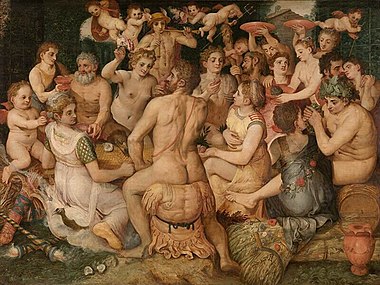1550 in art
The year 1550 in art involved some significant events and new works.
| |||
|---|---|---|---|
|
Events
- Antonis Mor is commissioned by Mary of Hungary to travel around Portugal and paint portraits of the Portuguese branch of her family.
- Giorgio Vasari publishes Le Vite de' più eccellenti pittori, scultori, ed architettori (The Lives of the Most Eminent Painters, Sculptors, and Architects) in Florence.
Paintings

Floris – Banquet of the Gods, Royal Museum of Fine Arts, Antwerp
- Sofonisba Anguissola – Bernardino Campi Painting Sofonisba Anguissola
- Lucas Cranach the Elder – Self-portrait at 77
- Frans Floris – Banquet of the Gods
- Maarten van Heemskerck – Adam and Eve/Gideon and the Fleece
- Jan Mandijn – The Temptation of St. Anthony
- Francesco de' Rossi – Portrait of a Young Man
- Titian – Venus and Musician (Venus with an Organist and a Dog, Museo del Prado)
Births
- April 18 - Alessandro Pieroni, Italian mannerist painter and architect (died 1607)
- date unknown
- Cristoforo Augusta, Italian painter, pupil of Giovanni Battista Trotti (died 1600)
- Matthijs Bril, landscape painter of frescoes who worked in Rome (died 1583)
- Aert Pietersz, Dutch painter (died 1612)
- Jan Sadeler I, Flemish engraver of the Sadeler family (died 1600)
- probable
- Piermaria Bagnadore, Italian painter and architect of the late-Renaissance period (died 1627)
- Pier Angelo Basili, Italian painter born in Gubbio (died 1604)
- Pieter Bast, Dutch cartographer, engraver and draftsman (died 1605)
- Giovanni Paolo Cavagna, Italian painter, active mainly in Bergamo (died 1627)
- Giovanni Battista Cremonini, Italian painter of primarily frescoes (died 1610)
- Pedro de Bolduque, Spanish sculptor of Flemish origin (died 1595)
- Wendel Dietterlin, German painter/architect, author of a treatise on the five orders entitled Architectura (1598) filled with Mannerist ornament (died 1599)
- 1548/1550: Palma il Giovane, Italian Mannerist painter from Venice (died 1628)
- Marcin Kober, Polish court painter to King Stefan Batory (died 1598)
- Giovanni Paolo Lolmo, Italian painter (died 1593)
- Sampson Strong, Dutch-born portrait painter (died 1611)
- Nicolas van Houy, Dutch Golden Age painter (died 1611)
- Hendrik van Steenwijk I, Dutch painter, earliest-known painter of architectural interiors (died 1603)
- Giovanni Vasanzio, Dutch-born architect, garden designer and engraver (died 1621)
- (born 1550/1551) Scarsellino, Italian painter, of the School of Ferrara (died 1620)
- Hans van Steenwinckel the Elder, Flemish/Danish sculptor and architect (died 1601)
- Đorđe Mitrofanović, Serbian portraitist, icon painter and muralist (died 1630)
Deaths
- September - Giovanni Maria Francesco Rondani, Italian painter of the Parmesan school (born 1490)
- September 7 - Niccolò Tribolo, Italian Mannerist artist (born 1500)
- 22 November - Sebald Beham, German printmaker, engraver, designer of woodcuts, painter and miniaturist (born 1500)
- October 11 - Georg Pencz, German engraver, painter and printmaker (born 1500)
- December 6 - Pieter Coecke van Aelst, Flemish artist of paintings and tapestries (born 1502)
- date unknown
- Antonio da Trento, Italian artist especially of woodcuts (born 1508)
- Antonio Fantuzzi, Italian etcher (born 1510)
- Gregório Lopes, Renaissance painter from Portugal (born 1490)
- Girolamo Marchesi, Italian painter (born 1471)
- probable - Innocenzo di Pietro Francucci da Imola, Italian painter and draftsman (died 1494)
gollark: Ugh, I just realised that Discord appears to have made the search mildly worse in the recent UI update.
gollark: Apparently, yes.
gollark: Nuclear waste is probably a problem, but less than climate change and the giant piles of spent lithium-ion batteries which would probably result from using batteries/solar.
gollark: Definitely nuclear power. It runs constantly unlike solar and whatnot, doesn't produce CO2, and uses fuel which we have enough of for a while and could use much more efficiently if there was much of an incentive to.
gollark: I'm also hoping some sort of comparatively cheap geoengineering-type solution is developed for climate problems, because otherwise we have basically no chance of hitting the not-heating-the-world-up-a-lot targets, unless the world ends up with a totalitarian ecodictatorship or something.
This article is issued from Wikipedia. The text is licensed under Creative Commons - Attribution - Sharealike. Additional terms may apply for the media files.